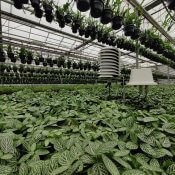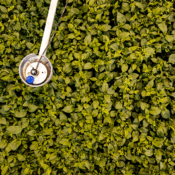Tackling pests and disease in an environment that’s anything but uniform
Readers of this month’s edition of The Grower, the technical journal for horticulture published by the AHDB might recognise a familiar image: the pointed microclimate sensor from 30MHz. In a contributed article, Ant Surrage, Technical Development Specialist at Fargro, goes in depth on the importance of quality data when crafting an integrated pest management (IPM) programme.

Growers, consultants and researchers in the 30MHz community have been demonstrating the impact of data-driven IPM, and we’re excited to see our technology be a part of their fight against pest and disease. Ant’s article highlights the key reasons why real-time insights are central to protecting crops from threats. At the core is a reminder to agribusinesses to never underestimate the variations in their environment.
“Growers must recognise that it is likely their environment is not uniform. Hotspots, areas of high humidity and areas of damp will be key areas for pest and disease establishment. This should inform monitoring and preventative programmes, which will have knock-on effects on other elements of an integrated pest management (IPM) programme.”

A combination of metrics on environment and crop-level insights (including dew point, vapour pressure deficit/VPD, absolute humidity/AH, humidity deficit and the absolute difference between air temperature and dewpoint) are all viewable within the ZENSIE platform, and provide the detailed overview needed to fight the range of insects, fungi and diseases that can compromise crop development.
“For even greater detail, growers can monitor and understand the microclimate. The microclimate refers to the environment around a plant, this is often significantly different to the environment we feel when walking through the crop. It is necessary to understand the microclimate.”
Real-time and historical data on environment and microclimate can help agribusinesses identify the conditions that lead to disease development, and optimise the conditions for biopesticide effectivity– a win-win that conserves crops as well as resources.


30MHz is typing… Our extended support team is ready to chat!
At 30MHz we think it’s important that our users can use our platform in an optimal way. At times you may have questions and you would like some help from our support team. Email and our support page filled with helpful articles were your go to’s. But we thought it was time for something extra… ...Read more
New 30MHz connect casing: How we protect your tech
To make sure your dataflow is fully protected, 30MHz introduces a new connect casing: waterproof, dust proof and even resistant to hits. This special shield will last longer and ensure a reliable dataflow from the connected sensor. What does that full protection mean? That’s what we will explain in this article. Watertight: resistant to wetness ...Read more
Most popular sensors for your greenhouse
As a grower, you know that optimal crop development starts with precise monitoring of your cultivation environment. But how do you transform raw data into actionable insights for your crops? This is where our wireless sensors and the 30MHz platform come together. Our sensors measure essential variables such as VPD, dew point, moisture deficit, EC, ...Read more


